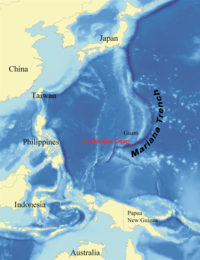
Photo from wikipedia
The low temperature and elevated hydrostatic pressure in hadal trenches at water depths below 6,000 m render sample collection difficult. Here, in situ hadal water microbial samples were collected from… Click to show full abstract
The low temperature and elevated hydrostatic pressure in hadal trenches at water depths below 6,000 m render sample collection difficult. Here, in situ hadal water microbial samples were collected from the Mariana Trench and analyzed. The hadal microbial communities at different depths were revealed to be consistent and were dominated by heterotrophic Marinimicrobia. Thirty high-quality metagenome-assembled genomes (MAGs) were retrieved to represent the major hadal microbes affiliated with twelve prokaryotic phyla. Most of the MAGs were newly reported and probably derived from novel hadal inhabitants as exemplified by a potentially new candidate archaeal phylum in the DPANN superphylum. Metabolic reconstruction indicated that a great number of the MAGs participated in nitrogen and sulfur cycling, in which the nitrification process was driven sequentially by Thaumarchaeota and Nitrospirae and sulfur oxidization by Rhodospirillales in the Alphaproteobacteria class. Moreover, several groups of hadal microbes were revealed to be potential carbon monoxide oxidizers. Metatranscriptomic result highlighted the contribution of Chloroflexi in degrading recalcitrant dissolved organic matter and Marinimicrobia in extracellular protein decomposition. The present work provides an in-depth view on the hadal microbial communities regarding their endemism and element cycles. This article is protected by copyright. All rights reserved.
Journal Title: Environmental microbiology
Year Published: 2019
Link to full text (if available)
Share on Social Media: Sign Up to like & get
recommendations!